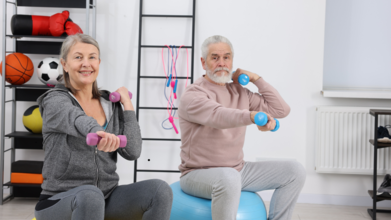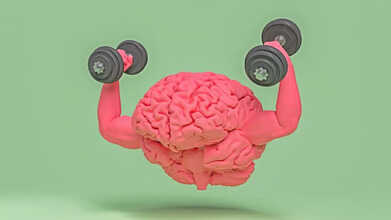- Health Conditions A-Z
- Health & Wellness
- Nutrition
- Fitness
- Health News
- Ayurveda
- Videos
- Medicine A-Z
- Parenting
- Web Stories
Feel Your Legs Tingling After Exercise? Here's Why It's A Cause Of Concern

Image Credit: Canva
The slight tingling of excitement before a workout is one thing, but feeling your legs tingling after exercise may raise concerns about whether it's a sign of overexertion, a harmless side effect, or something more serious. Though occasional tingling might not be a cause for concern, persistent or frequent sensations are something that deserves your attention.
This article is a detailed analysis of what may be causing the discomfort, when to be concerned, and how to treat it.
Tingling is often described as "pins and needles." It occurs when your nerves send abnormal signals to your brain. The sensation can be localized to your calves or thighs or spread across your legs. It is scientifically known as temporary paresthesia and can be caused by a variety of triggers, some benign and others concerning.
During exercise, blood flow to your muscles increases significantly. This process powers your workout but can also compress surrounding nerves, leading to tingling. While this is usually temporary, it's not the only factor to consider.
Why Does Tingling Happen After Exercise?
1. Histamine Response
One of the most common but surprising causes of post-workout tingling is your body's histamine release. As you exercise, your body produces histamines to improve blood circulation and oxygen delivery to your muscles. It is a very natural process used to combat fatigue, but it may also create tingling or an itching sensation that is often located in the lower extremities.
While usually harmless, intense itching or chronic tingling should be discussed with your doctor to rule out rare allergic reactions.
2. Circulation Problems
Other possible causes of tingling in the legs include restrictive workout gear, such as tight shoes or compression clothing, which can limit blood flow to your legs. A more serious condition, such as peripheral artery disease (PAD), may also be the cause. PAD is a condition in which plaque builds up in your arteries, restricting blood flow and causing discomfort or tingling during exertion.
When to Worry
- Tingling persists after removing restrictive clothing or shoes.
- You have pain or cramping in your legs when you exercise.
3. Electrolyte Imbalance
Electrolytes include sodium, potassium, calcium, and magnesium. They are essential for muscle function. When you sweat during exercise, you lose these minerals, and an imbalance may cause tingling or cramping.
Hydrate with water or electrolyte-rich drinks before, during, and after exercise. Make sure to eat foods such as bananas, spinach, and almonds.
4. Nerve Compression and Pinched Nerves
If the tingling goes from your lower back down both legs, it may be a sign of nerve compression. The cause could be spinal stenosis or a herniated disc. These are usually caused by repetitive stress, poor posture, or aging.
When to Worry
- Pain that shoots down both legs.
- Tingling worsens when standing and improves when seated.
- Changes in balance or coordination.
Consult a doctor if the symptoms persist. Physical therapy or specific exercises may relieve pain.
5. Overworked or Injured Muscles
Excessive exercise stretches or strains muscles in the lower back and legs, leading to tingling. Sacroiliac (SI) joint injuries are very common among runners and other people doing high-impact exercises.
When to Worry
- Tingling localized to one leg.
- It has an association with a particular step or injury.
Untreated such injuries can turn chronic and pose difficulty in the ability to move the affected limb or limb area. Treatment through a medical practitioner is advisable.
Also Read: How To Get Rid Of The 'Pins And Needles' Feeling In Your Foot?
Rare Serious Conditions That Causes Post-Workout Tingling
1. Chronic Exertional Compartment Syndrome (CECS)
This is a very rare condition whereby pressure builds inside the muscle compartments, thereby affecting blood flow that leads to numbness, stiffness, and swelling. Symptoms typically worsen at exercise and can persist post-exercise.
Treatment
Early intervention is essential. Surgery may be needed in extreme cases to relieve the pressure.
2. Entrapment Syndrome
In this condition, blood flow to the legs is impaired because of trapped arteries, often behind the knee. This leads to tingling, pain, or a feeling of heaviness in the lower leg.
Treatment
Entrapment syndrome may resolve with rest, but persistent cases often require surgical intervention.
When to See a Doctor
Although mild tingling may be considered a normal condition following exercise, there are times when you should see a doctor. Here are some signs that indicate a need for medical attention:
- Persistent tingling that lasts for hours or days.
- Tingling that is accompanied by severe pain, swelling, or discoloration.
- Numbness or changes in the temperature of the legs.
- Symptoms that affect daily activities.
Prevention and Recovery Tips
- Stretching of muscles before exercising, as well as cool down afterward, to ensure proper circulation
- Proper fitting shoes and light breathable clothing avoid any kind of blockage in blood flow
- Hydration and replenishment of electrolytes if exercising for long hours or intense exercising
- Rest if feeling fatigued or uncomfortable; avoid forcing oneself to work through pain.
Tingling in your legs after exercise can be as innocuous as tight shoes or as serious as a nerve or circulation issue. The trick is knowing your body and knowing when the sensation is normal exertion and when it is a red flag for something more serious.
Herniated Disc. American Association Of Neurological Surgeons. 2024
Leg symptoms associated with sacroiliac joint disorder and related pain. Clin Neurol Neurosurg. 2017
Exercise-Associated Numbness and Tingling in the Legs. Arch Neurol. 2011
Working Out These 5 Zones Can Help Older Adults Stay Fit, According To Fitness Expert

Credits: Canva
Strength training becomes increasingly important as people age, but many older adults make the mistake of training only the muscles they see in the mirror. According to Marfred Suazo, a New York City, based fitness professional known as “Fonz the Trainer,” who spoke to Fox News, targeting overlooked muscle groups is the key to moving well, staying pain-free, and living independently.
Suazo, who has trained thousands of seniors, shared with Fox News Digital which areas of the body matter most as we get older, and why focusing on them builds true longevity.
Moving Beyond “Mirror Training”
“Most people train what they see in the mirror, chest, arms, quads, and maybe abs if they’re feeling ambitious,” Suazo told Fox News Digital. “That’s what I call mirror training.”
While this type of workout may boost appearance, Suazo explained it leaves people unbalanced, with rounded shoulders, tight chests, and sore backs or knees.
“If you want to age strong, pain-free, and confident, you need non-mirror training,” he said. “That means working the muscles you don’t see but feel every single day.”
Zone 1: Power Zone — Glutes and Hamstrings
These muscles form the foundation of movement, helping with sitting, standing, climbing, and protecting the lower back.
“Your glutes and hamstrings give you the power to move with confidence,” Suazo said. He recommends deadlifts, hip thrusts, and single-leg bridges. “Control the movement, squeeze at the top, that’s where the real work happens.”
Zone 2: Posture Zone — Upper and Mid-Back
Strengthening the back keeps the body upright and breathing freely. Without it, posture often collapses into a slouch as people age.
“A strong back pulls your shoulders into alignment,” Suazo explained. His go-to moves include bent-over rows, cable rows, and bodyweight rows. “Pull through the elbows and picture yourself standing taller with every rep.”
Zone 3: Stability Zone — Core and Obliques
The core isn’t just about six-pack abs, it’s about stability and spine protection.
“True core training teaches your body to brace and protect your back during daily life,” Suazo said. His favorite move is the Paloff press: anchor a band, press it straight out, and resist rotation. “It’s simple, but it trains real-world stability.”
Zone 4: Mobility Zone — Shoulders and Rotator Cuff
Shoulders are involved in almost every upper-body movement. When they’re weak or stiff, everything else suffers.
“Healthy shoulders are a must if you want to keep training for decades,” Suazo told Fox News Digital. He suggests face pulls, rear delt flies, band rotations, and controlled overhead presses. “This combination keeps shoulders strong and mobile.”
Zone 5: Grip Zone — Hands and Forearms
Grip strength is directly linked to independence as people age, yet it’s often one of the first things to decline.
“Grip strength makes a difference in every other lift and in everyday tasks,” Suazo said. He recommends farmer’s carries — aiming to carry about 70% of body weight in total — as well as simple hangs from a pull-up bar.
A Simple Routine to Start
For beginners, Suazo suggests a quick non-mirror workout:
- 3 sets of 8–10 deadlifts
- 3 sets of 10 Paloff presses per side
- 3 farmer’s carries for 30–45 seconds each
- A short walk to finish
- Training for Longevity, Not Just Looks
Suazo emphasized that safety and form come first, especially for older adults. “Controlled movement matters more than how heavy you go,” he said. Warming up, progressing gradually, and listening to the body are essential.
“Non-mirror training is how you stay strong, upright, and pain-free,” Suazo added. “When you train the muscles behind you, the ones in front look and perform better too.”
Fitness Coach Reveals 7 'Cheat Codes' That Help You Burn More Calories While Walking

(Credit- Canva)
What is an exercise that not only needs minimal equipment, but is also the most accessible for everyone, no matter how young or old they are? It is walking. Not just by fitness coaches, but also healthcare professionals, walking is regarded as one of the best ways to stay fit and healthy.
If you are looking to lose weight, but are worried about committing to a gym membership that you may not be able to finish, then you do not need to worry about elaborate home workouts, all you need is a pair of shoes and time to take a powerful stroll. But did you know, you could maximize this time and make your walking more efficient? Not only will this allow you to make the most of your time, but it will also help you lose weight easier?
According to fitness coach Dan Go, you can make your walks far more effective. He's developed a set of simple "cheat codes" that can help you burn more fat, significantly boost your energy levels, and even add years to your life. It's often seen as a simple, low-impact activity, that is easy to adjust to your levels of fitness. These small adjustments to your walking routine can lead to truly massive results.
7 Walking Tricks To Help You Lose Weight
Japanese Interval Walking
Forget boring, steady walks. This method involves a powerful rhythm: walk fast for three minutes, then slow for three minutes. Repeat this for 30 minutes. This style of walking is scientifically proven to burn more fat and significantly boost your fitness more effectively than a constant pace.
Walk on an Incline
Adding an incline to your walk, either on a treadmill or a hill, dramatically increases your calorie burn. A 5% incline can boost your burn by 50%, and a 10% incline can double it. It’s also gentler on your joints and works your glutes and hips more.
Walk After Meals
Just a short 2-5 minute walk after eating can make a huge difference. This simple habit helps lower blood sugar spikes by about 30%, which means you'll have fewer cravings, steadier energy, and your body will be less likely to store fat.
Try a Fasted Morning Walk
Walk before you have breakfast. When you walk on an empty stomach, your body is more likely to use stored fat for energy. Doing this outside also helps set your natural body clock and gives you a refreshing boost to start your day.
Walk While You Work
For those with a busy schedule, a treadmill desk is a fantastic solution. You can get in thousands of steps while you're at your standing desk. This lets you multitask and be active during meetings or while you're working on tasks.
Pyramid Walking Intervals
This method is a great way to improve endurance and burn fat. Start with an easy 5-minute warm-up, then gradually increase your speed and incline every 10 minutes. Finish with a four-minute push at your toughest pace before a cooldown.
Rucking
Turn your walk into a full-body workout by wearing a backpack with 5-10% of your body weight. This simple addition helps you burn more calories, while also strengthening your legs, core, and bones simultaneously for a more challenging and effective walk.
Can Leg Workouts Help Protect Your Brain From Ageing? Expert Weighs In

Credits: Canva
If staying sharp as you grow older is the goal, skipping leg day may not be the best idea. New findings suggest that your brain could benefit just as much as your body from squats and lunges.
A long-term study, first published in Gerontology by Karger Publishers, tracked older female twins for ten years to explore the link between leg strength and cognitive health. The results were clear: participants with stronger legs at the beginning of the study experienced far slower cognitive decline than those with weaker leg muscles.
To understand this connection better, we spoke with Dr. Indramani Upadhyay, MPT (Ortho), HOD – The Center for Knee & Hip Care, Vaishali, Ghaziabad, who shared his insights on the subject.
The Leg–Brain Connection
When we think about keeping the mind sharp, the usual suggestions include solving puzzles, reading, or practicing meditation. Yet growing research shows that one of the strongest ways to support brain health actually starts with the legs. As per Dr Upadhyay, strong leg muscles do more than keep us steady, they play a vital role in protecting memory, learning, and overall cognitive function.
Because the leg muscles are the largest in the body, every time they are put to work they send powerful signals that influence brain chemistry, circulation, and even the growth of new cells. Studies highlight several key benefits:
- Better blood flow: Leg-focused exercises improve circulation, delivering oxygen and nutrients the brain relies on.
- Myokine release: Contracting muscles release proteins known as myokines, which travel through the bloodstream and support nerve health and brain adaptability.
- Neurogenesis boost: Weight-bearing moves like squats and lunges may encourage the growth of new neurons in the hippocampus, the region responsible for memory and learning.
- Stress balance: Physical activity in the legs helps regulate hormones, easing inflammation and reducing stress—two major factors linked to cognitive decline.
Which Leg Exercises Boost Brain Health?
Dr Indramani explains that keeping your legs active does far more than build strength or tone muscles, it also supports brain health. Here are some of the most effective exercises:
1. Strength Training (Squats, Lunges, Step-Ups)
Movements that use your body weight or added resistance work the largest muscle groups in the legs. These exercises not only build muscle and protect bone health, but they also trigger the release of growth factors that sharpen memory and learning.
2. Walking and Jogging
Brisk walking or light jogging are simple yet powerful ways to improve cardiovascular fitness. Better circulation means more oxygen-rich blood reaches the brain. Walking outdoors adds even more value by lowering stress and boosting focus.
3. Cycling
Whether on a road bike or a stationary one, pedaling engages the legs continuously, keeping endurance and blood flow steady. Research links cycling to better reaction times, sharper executive function, and a lower risk of age-related cognitive decline.
ALSO READ: Ebola Outbreak: Why African Countries Are Disproportionately Impacted By The Disease?
4. Yoga Poses (Tree, Chair, Warrior Stances)
Balance-focused yoga postures recruit the legs while also improving flexibility and coordination. This mindful movement helps ease anxiety, sharpen concentration, and strengthen the mind-body connection.
Putting It All Together
The most effective routine is a balanced one: strength training two to three times a week, daily walking or cycling, and yoga for flexibility and balance. Together, they create a foundation that protects both body and brain.
Your legs are more than just a means of movement. They are engines that power your mental resilience. Keeping them strong is an investment not only in mobility but also in memory, focus, and long-term brain health.
© 2024 Bennett, Coleman & Company Limited

